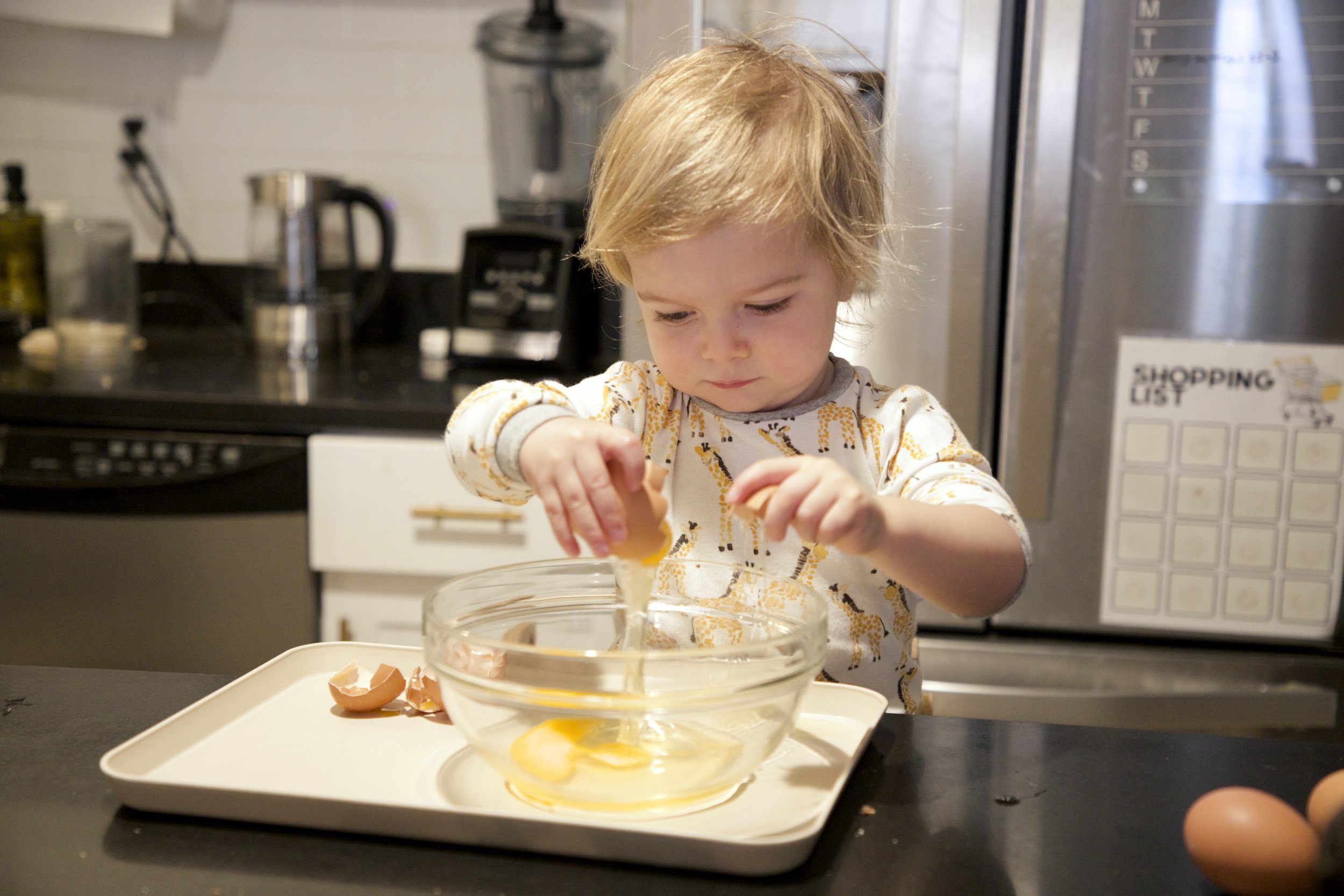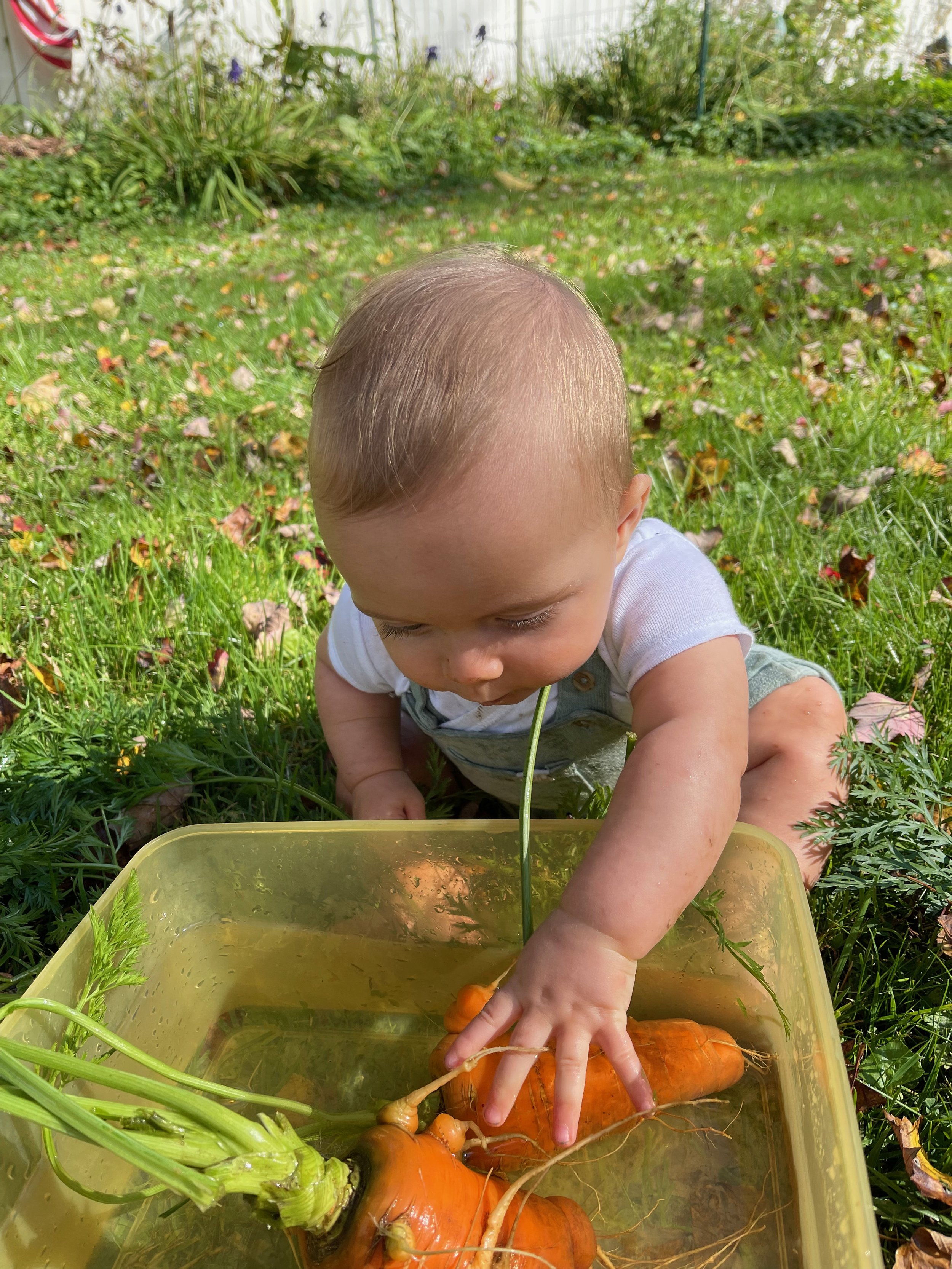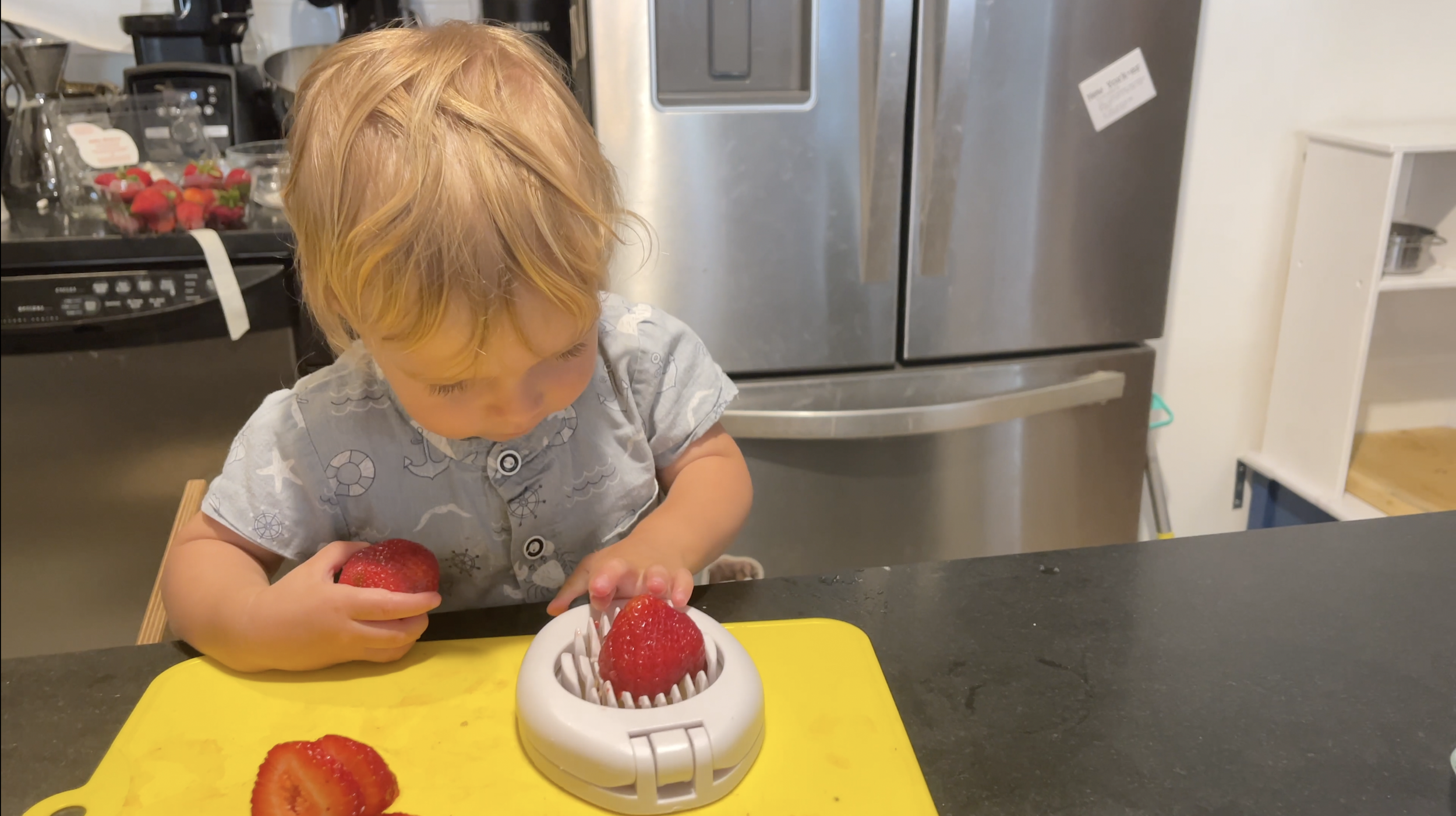Cooking with Toddlers: Where to Start
This post may contain affiliate links, which means I may earn a small commission if you buy through my link but does not change your price.
Where do you start? This is quite possibly my most asked question when it comes to cooking with toddlers or even our Montessori home more generally. It is also a question I struggle a bit with because I don’t have a straightforward answer. But, I will do my best to share our experience along with some of my tips here. This will be the first in a series I will share about introducing different aspects of cooking.
I have an almost 2-year-old and a newborn currently. In our home practical life activities are the core way we do Montessori. Practical life activities are everyday activities like cooking and cleaning. Cooking in general is a huge part of our Montessori home. My toddler loves the kitchen and is, in my opinion, quite skilled there. Cooking is one of our favorite activities to do together and we have had many many hours of practice. Please keep in mind every child is different. Cooking is a huge interest of ours and we love doing it together. I share ages for reference but they really vary so greatly.
Where We Started
In so many ways I feel like we started with him in the kitchen from the beginning. I would have my son in the carrier as I cooked and I would narrate what I was doing. I introduced scents to him, letting him smell spices as I put them in. This early observation is, in my opinion, very valuable despite it not being him “cooking” yet. Now this is where I am with cooking with my daughter.
At around 6 months old when my son started sitting up I would put him in the Inglesina clip-on highchair on our bar. He got a better view here and this is also when I introduced vegetable washing. I would give him a container of water (sometimes very little, sometimes enough to really dunk the vegetable) and let him move the vegetable around in it. While this might not be the most effective washing method, it was easy for him to do and he got to experience the vegetable with all his other senses. He also spent a lot of time playing with cooking utensils, pots and pans, etc.
At 10 months we got our learning tower. This opened up far more opportunities. We didn’t use it a ton for the first couple of months but it became our most used item after around a year. When I first got the tower I also started introducing peeling bananas. I would hold the banana, start it on top, and he would peel it down. Other than that, at this age I would pour with him occasionally where both of us would hold the measuring cup at once.
A little after a year my son started getting far more involved. I continued to have him wash vegetables, mix things, mash things, and peel bananas, but I also introduced a lot more skills as he showed interest. Around 13 months he started transferring things for me. I would cut and he would transfer them into the bowl or pan.
Around this time as well I introduced pouring independently. Many introduce dry pouring first but we started with water. First I had him water plants (large surface area to get the water in and can be done well outside). Then he practiced pouring into a glass on a tray. After a few weeks, at around 14 months, he got pretty good at pouring himself water into a glass and I started having him really do the pouring in the kitchen. There were many spills for a long time. Another strategy is to practice either outside or in the bathtub where the mess is not a concern.
Also around 14 months we first introduced cutting with an egg slicer as well. I am going to share all about how we introduced knives in a later post as that is an in-depth progression itself.
We also began to introduce more types of peeling. I started having him peel mandarin oranges (he was doing this from around 15 months) which are more difficult than bananas and then eggs and onions.
Other than our cutting progression which I will share later, much of what came after 15 months was a refinement of these skills. I did introduce egg cracking at 16 months, but mostly he was becoming more skilled at pouring different substances without spilling, stirring successfully without it all flying out, etc. He also went from single to multistep processes. For example, when I first introduced the egg slicer I would help him through each step. At 15 months he would take a mushroom, wash it, cut it, and put it in the bowl.
At 19 months I introduced my visual recipes which were so helpful for him really taking control in the kitchen. He would lead the cooking, asking me for things as he saw them on the recipe. I also began allowing him to scoop some of the time instead of giving him all premeasured cups and spoons. Prior to this I had started mostly scooping in front of him. Premeasuring everything into little bowls before he came into the kitchen can be very helpful for a baking project but I found it unrealistic when he was involved in so much of our day-to-day cooking.
We have not yet introduced the stove. I do take pans that were on the stove and put them in front of him for him to add things to. He understands they are hot and he cannot touch them. He has never touched them which gives me more confidence for when we eventually introduce the stove.
Setting Yourself up for Success: the Prepared Environment
I would say the two biggest concerns I hear from people about cooking with toddlers are about the mess and about them eating everything. For both these concerns, but particularly the first, I think the prepared environment can be so helpful in making the experience a positive one. The prepared environment is a central tenet of Montessori and it is so crucial when it comes to cooking.
My number one recommendation for preparing the environment is a learning tower. There are many options that I will go through in a future post, but we have the Sprout Kids one at home and love it (code OnTheWay10 for a discount) and the Piccalio kids folding one at my parent’s house. While a learning tower isn’t a must by any means it is a great investment for cooking with children. It’s a safe way to bring them up to the counter and a lot more secure than a chair or open stool. Of course, a short table and bringing things down to the child’s level is also an option but working together at the counter is really nice! When my son was first starting I would sometimes bring things down to the floor and let him wash vegetables on the floor.
After a learning tower, I recommend getting some child-sized tools. While it is always an option to use adult tools I find it is way more ergonomic and as a result, less messy, to use child-size ones. I got a set with a whisk, spatula, and rolling pin. We use all of these on a regular basis. I find when he is using a smaller child-sized utensil food doesn’t fling from what he is stirring nearly as much as with adult ones. Even today when cooking is generally less messy when I give an adult wooden spoon the food often flies everywhere.
To control the mess I also recommend a tray. This means most spills can easily be poured back into the mixture (less waste!) and it keeps the mess contained. I got a set of four dishwasher-safe ones so we always have a clean tray. Baking trays work totally fine too. I used them for several months before purchasing my trays. However, I didn’t like putting them through the dishwasher so much which I wanted to be able to do with the trays.
Small rags for wiping up spills at the ready allow the child to be involved with cleanup as well. I found starting this habit from the start to be very helpful. I would model cleaning up and give him an opportunity as well. Now having a rag next to him allows him to clean spills when he notices them. I often do forget, however, and he will now ask me for a rag.
Little bowls to put ingredients in can be helpful, particularly at the start. These days I do not premeasure as often. I like having him part of the whole process and that includes waiting for me to measure or measuring himself, but premeasuring was very helpful when we first started. I also will still put things in little bowls if it feels easier.
As much as possible prepare the environment with an empty counter in front of them. We live in a small apartment and that is not always completely possible. However, as much as possible I want the counter area in front of him empty except for what he is working with. This avoids him just grabbing at everything and keeps it way calmer for both of us.
I also recommend keeping at least some cabinets safe for them to explore. Having areas in the kitchen such as cabinets they can safely explore can be a great place to redirect if cooking together isn’t working at a specific time. This still allows them to observe and keeps them busy. Banging pots and pans and mouthing cooking equipment might not be cooking but it is exposure.
Setting Yourself up for Success: The Prepared Adult
The other half of setting up for success is preparing yourself. There were times, especially in the beginning, when I knew I was not in the headspace to cook with him so I would do it while he was napping or with my husband. Now that’s far rarer since he is so used to cooking, but it occasionally happens. You want to be in a headspace you can handle the mess, speed, and boundaries of cooking with a toddler.
You also want to make sure you are okay with something spilling and being lost. While the tray does mean I can rescue most spills sometimes ingredients are lost. I am conscious of only giving him ingredients that I would be able to handle losing. And before people complain about food waste- I believe it, like the mess and “waste” of learning to eat, is worth it. I don’t truly think it is waste if some food is lost while gaining these valuable skills and building a connection.
Knowing what your boundaries are is also an important part of being a prepared adult for cooking with toddlers. You will want to set boundaries around how things are used and expect that those boundaries will be pushed. Nothing is learned immediately. For example, in a neutral tone remind your toddler that food stays on the counter if they are throwing it. If the throwing continues I would stop the activity and redirect to a place throwing is okay. If possible, have them help clean up. You want to avoid a big reaction though. Remember toddlerhood is all about experimenting. You can also try practicing on the floor first to reduce the temptation to throw off the counter. This is also the reason I love having cabinets children can explore. It allows for redirection without banishing a child from the kitchen if cooking together isn’t working on a specific day.
The same goes for tasting while cooking. There I recommend working on the boundaries prior to introducing eggs (or other things that are not safe to be eaten raw) so that you can be confident your child will not be eating the raw dough. We want to make sure we can meet the child where they are. Starting with something like peeling a banana or transferring vegetables is great for that. I allow my son to eat some of the banana, for example, but he knows when I say something is unsafe to taste he cannot eat it. Being the prepared adult in this circumstance also means knowing if you taste something they will want to, too. I try to be conscious of that with anything I taste. If it’s unsafe for him, I avoid it (which I find hard because I LOVE raw cookie dough). If I don’t mind him having, we both taste.
I also try to prepare myself ahead of time by thinking through tasks I can give him. I want to keep him busy as much as possible. When he isn’t busy he is far more likely to try to grab things off the counter, try to climb out of the tower, etc. Sometimes this means giving him a bit of what I’m working on such as a small bit of dough to roll out while I roll out the rest. Other times this looks like keeping busy while he does one thing preparing the next thing for him. I also do at times create jobs that, while necessary in a way, take a lot longer the way I am having him do them. If I know I don’t have many tasks for him instead of pouring frozen vegetables into the pan I will first have him transfer them to a bowl for me, for example. This task takes a while and allows me to work on other things in the meantime. Peeling onions is a favorite long activity for me that keeps him busy while I prep other parts of the meal.
Simple Ways to Start
Here are some very simple one-step tasks to start your toddler in the kitchen!
Pour milk into cereal
Peel a banana
Wash vegetables in a container of water (offer a vegetable brush depending on age)
Transfer vegetables from the cutting board to baking tray
Shake spices into a mixture
My main recommendation for getting started though is just to start. You don’t need to plan fancy baking activities. In fact they might be more stressful. Transferring vegetables onto a tray for dinner is a great first step. So much of it is just getting started and practicing. Starting with simple recipes with taste-safe ingredients can be a helpful starting point. Smoothies are a great one, for example. It will be messy at first, likely quite messy, but over time it becomes less messy and stressful. At this point cooking with my son is rarely significantly messier if messier at all than cooking alone would be for me. But that took lots and lots of practice. Even just welcoming your child in to observe, smell spices, and listen to what you are doing is valuable.
Of course, every child is different. Cooking with my son became the one way I could get food on the table. If he preferred to play with toys during this time though I would happily have him do that. It is all about welcoming and inviting, not forcing.
Stay tuned for more parts of this series on introducing cooking to babies and toddlers!






